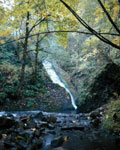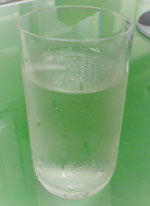

− Contents −
1.Basic of Water
§1.Water and the Earth
・Watery planet
・Water circulation
・Water and life
・Desertification and drought
・International river conflicts
・21st century is water
§2.Tap Water
・Taste of tap water
・Harmful matters in tap water
・Matters disturbing taste
§3.Delicious Water
・What is good taste water?
・The position of mineral water
・The factors for good water
・Components of good water
2.Water Crisis
3.Environment Measure



|
Chapter1 Basic of Water

In tap water, although it is absolutely under the water quality standard regulated by water supply law, the water contains harmful substance such as trihalomethane, trichloroethylene, and simazine, mold odor, and residual chlorine which "disturb the good taste of water."
In the process of tap water, water is stored in water treatment plant and settled down for impure substance such as sands. Then, filtering treatment is conducted to remove fine substances. After that, sterilization treatment by chlorine is conducted to remove bacteria. In Japan, the amount residual chlorine is regulated by water supply law.
(more than 0.1 ml gram in 1 liter tap water)
By chlorine, harmful bacteria are perfectly wiped up.

However, chlorine in tap water is the one of the factors which change the taste to be distasteful. In general, tap water has chlorine odor. Although chlorine itself doesn't have bad smell, chlorine odor emerges by eaction between chlorine and bacteria. Water which has lots of bacteria requires more chlorine, thus smelling more like chlorine. That means, areas where have more chlorine odor have more water contamination.
Moreover, it has been reported that chlorine causes serious issue. When organic matters in water reacts with chlorine, trihalomethane is produced. If people has lot os trihalomethane, they damaged central function, liver, and kidney. Furthermore, trihalomethane has the factor of teratogeny and cancer as well as the risk of dementia, frustration, tiredness, and lassitude.
Even that, since there might be bacteria such as O157 which have affects on human body, chlorine treatment should be carried out. To decrease chlorine amount, it should purify water source itself to decrease bacteria amount as first step. Currently, advanced purification treatment which uses ozone and activated carbon has been carried out to remove chlorine odor and mold odor so that water becomes better taste.
Harmful matters in tap water
- ・Trihalomethane
- Trihalomethane in tap water is produced by reaction between chlorien and organic matters in the water. The organic matters are mostly humic substances which emerge during the process of acidity of plant celluloses. In case of lakes and marshes, most of humic substances are phytoplankton.
Trihalomethane is the substance which changes to halide composed of 4 hydrogen atoms, chlorine, bromine, and iodine. In water supply law standard, chloroform (CHCl3), bromodichloromethane (CHBrCl2), Dibromochloromethane (CHBr2Cl), and Bromoform (CHBr3) are regarded as the target and the total of them is called total trihalomethane.
- ・Trichloroethylene(organic solvent)
- It is a type of chlorinated organic compound and it is colorless. The main use of trichloroethylene is deoiling wash for metal machine parts, dry cleaning, extraction of incense, and solvent for dying. The effects on human body are known as damage of livers, kidney, and central function. Moreover, Trichloroethylene is regarded as the pollution of underground water by wastewater.
- ・Simazine(Agricultural chemical)
- Simazine is white solid agricultural chemical, and it is used for pesticide toward vegetables, fruits, and grass. The spraying timing is Spring and Autumn when weeds grow. Since it has higher safety, it tends to remain. It mixes to underground water by rain and in tap water.
Matters disturbing the taste
- ・Mold odor
- The factor of mold odor is 2-Methylisoborneol, and it is produced by algae and actinomycete in lakes, marshes, and rivers. Water temperature which mold odor emerges is 20 to 30℃, and sometimes it emerges from 10 to 15 ℃. The targeted water index is "less than 0.02μg/l" in case of powder activated carbon treatment while "0.01μg/l" in case of granular activated carbon.
- ・Residual chlorine
- By chlorine agent for sterilization in treatment plant, chlorine odor emerges. Residual chlorine is effective chlorine which stays in water. The uses of chlorine are sterilization and bleaching for industry and houses. It is used for tap water, pool, and food industry sterilization.
In Japan, by water supply law, it is regulated that tap water is sterilized by chlorine and certain amount residual chlorine is stored in a hydrant.
In the water supply law in Japan, floating residual chlorine should be more than 0.1 mg/l (in case of combined residual chlorine, it should be 0.4 mg/l). If there is the risk of pathogenic microorganisms, it should be 0.2 mg/l (in case of combined residual chlorine, it should be 1.5 mg/l). In the targeted comfortable water quality, it should be less than "1 mg/l."
|
|






